1988 Countdown #39: Rick Astley, “Never Gonna Give You Up”
(New to the countdown? Catch up here.)
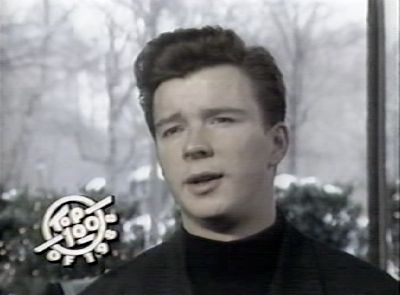 Rick Astley holds forth, in a thick northern English accent, in front of a glass window; behind him, we can see New York City in wintertime. “I don’t like being in front of cameras,” he says, looking straight into the camera, and laughs uncomfortably. “So I find that quite hard, you know. As I said before, I’m quite a shy person in a lot of ways. So to bop around in front of a camera, I find very hard, you know. I find doing TV’s very hard. Singing in front of a real audience, I don’t find that a problem. I feel confident then. So it’s been quite a difficult thing to get used to.”
Rick Astley holds forth, in a thick northern English accent, in front of a glass window; behind him, we can see New York City in wintertime. “I don’t like being in front of cameras,” he says, looking straight into the camera, and laughs uncomfortably. “So I find that quite hard, you know. As I said before, I’m quite a shy person in a lot of ways. So to bop around in front of a camera, I find very hard, you know. I find doing TV’s very hard. Singing in front of a real audience, I don’t find that a problem. I feel confident then. So it’s been quite a difficult thing to get used to.”
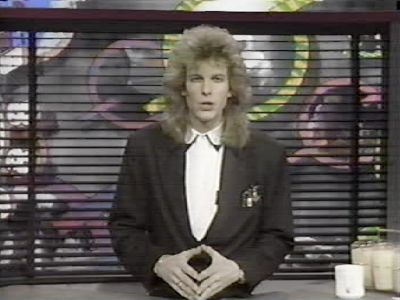 We cut to Adam Curry, who calls Astley “Slick Rick” and confidently declares that since the time of that interview, Astley has grown accustomed to cameras. Pressing his fingertips together, Curry recaps Astley’s success: “in 1987, his hit ‘Never Gonna Give You Up’ was the hit of the year in the UK and in Europe, and it also went to number one in the States in 1988.” He does not mention that two decades later, it would be huger than ever (69 million YouTube plays and counting, at this writing). I choose to believe that this is not because Adam Curry didn’t know the future, but because he didn’t want to blow our minds by explaining the Web, YouTube, and Rickrolling.
We cut to Adam Curry, who calls Astley “Slick Rick” and confidently declares that since the time of that interview, Astley has grown accustomed to cameras. Pressing his fingertips together, Curry recaps Astley’s success: “in 1987, his hit ‘Never Gonna Give You Up’ was the hit of the year in the UK and in Europe, and it also went to number one in the States in 1988.” He does not mention that two decades later, it would be huger than ever (69 million YouTube plays and counting, at this writing). I choose to believe that this is not because Adam Curry didn’t know the future, but because he didn’t want to blow our minds by explaining the Web, YouTube, and Rickrolling.
We begin the video with some electronic drumbeats and meet Mr. Rick Astley, who is dancing, or doing his best simulation of it: he shimmies in place, shifting his weight from one foot to the other. Spoiler alert: this is basically what he does for the entire video. He’s dressed like he’s meeting a girlfriend’s family for dinner, in a striped polo shirt and a dark jacket. He doesn’t know what to do with his hands, so he keeps opening and closing them.
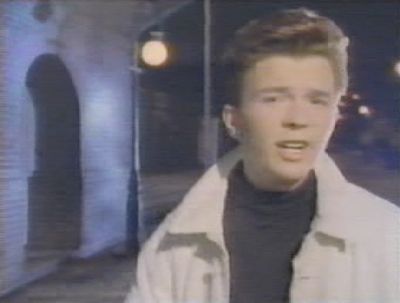 We cut to Rick outside at night, in front of a stone wall with two archways. He’s wearing a black turtleneck and a white trenchcoat, and is doing the exact same almost-a-dance. There’s also a platinum-blonde girl in a sleeveless black shirt, who is dancing, marginally more gracefully than Rick.
We cut to Rick outside at night, in front of a stone wall with two archways. He’s wearing a black turtleneck and a white trenchcoat, and is doing the exact same almost-a-dance. There’s also a platinum-blonde girl in a sleeveless black shirt, who is dancing, marginally more gracefully than Rick.
Still in the instrumental intro, we get a third look for Rick: outside in the sunshine, in front of a chain-link fence, with a blue work shirt buttoned all the way up and a pair of sunglasses. These are the many moods of Rick, I suppose. His British pallor makes him look like a twerpy vampire, but for some reason, he doesn’t explode into flames. He keeps doing his weight-shifting routine. There’s another platinum-blonde girl, this one in a sleeveless white shirt, and she spins around.
“You’re no stranger to love,” Rick sings, and sweet mother of Barry White, this 22-year-old who looks 12 has a baritone coming out of his throat that sounds like it must have been surgically implanted. This was the essential experience of watching a Rick Astley video: the incongruity of a hapless, vaguely handsome British kid having one of the biggest voices in pop music.
Rick pledges his fealty to his love interest–“a full commitment’s what I’m thinking of”–while we cut between his two outdoor looks (with a dash of the platinum blondes for variety). The camera is moving around as fast as it can, swooping past Rick in an effort to give him some extra energy. Then we hit the chorus and return to the striped polo look. Rick is indoors, singing on a stage in what looks like a cavernous restaurant. The joint is devoid of customers: the idea is presumably that he’s practicing his act (with the two blondes serving as his backup dancers) before the evening rush, not that every paying customer has bolted down their food and fled.
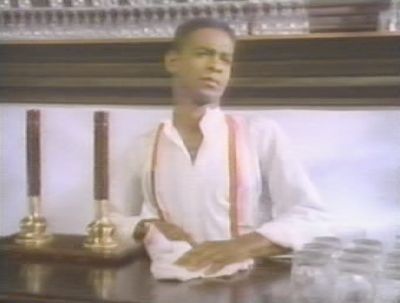 The restaurant’s bartender is wiping down the bar. He’s wearing a white shirt and red suspenders, he’s handsome, and he’s black. This proves to be important, as he will act out a brief drama of a crossover hit: first he looks up skeptically at Rick; then he nods approvingly while tossing a drinking glass in the air, catching it, and polishing it; then he starts dancing behind the bar; and finally he starts really rocking out, doing spins and jumping up so he can do a split and touch his toes in midair. Since it’s hard to imagine anyone whiter than Rick Astley, this performance plays as a cross-racial seal of approval. It also helps to have somebody in this video who can really dance, since it is basically a disco tune.
The restaurant’s bartender is wiping down the bar. He’s wearing a white shirt and red suspenders, he’s handsome, and he’s black. This proves to be important, as he will act out a brief drama of a crossover hit: first he looks up skeptically at Rick; then he nods approvingly while tossing a drinking glass in the air, catching it, and polishing it; then he starts dancing behind the bar; and finally he starts really rocking out, doing spins and jumping up so he can do a split and touch his toes in midair. Since it’s hard to imagine anyone whiter than Rick Astley, this performance plays as a cross-racial seal of approval. It also helps to have somebody in this video who can really dance, since it is basically a disco tune.
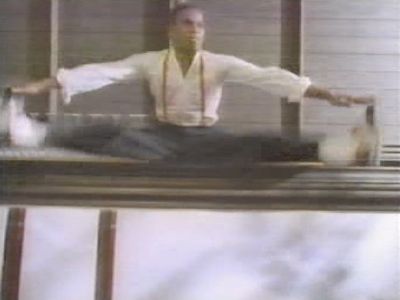 The song is the heavily synthesized work of British production team Stock-Aitken-Waterman. In the UK, they were oppressively successful from 1986 to 1990 with their assembly-line hits, but many of their flagship artists, such as Kylie Minogue and Jason Donovan, never really cracked the States. Rick Astley was a drummer-turned-singer in a soul band who worked as a tape operator and “tea boy” (British for “gofer”) in the Stock-Aitken-Waterman studio. Even before Rickrolling, this song worked people’s nerves: witness Nick Lowe‘s 1990 track “All Men Are Liars,” featuring the lyric “Do you remember Rick Astley? / He had a big fat hit that was ghastly.”
The song is the heavily synthesized work of British production team Stock-Aitken-Waterman. In the UK, they were oppressively successful from 1986 to 1990 with their assembly-line hits, but many of their flagship artists, such as Kylie Minogue and Jason Donovan, never really cracked the States. Rick Astley was a drummer-turned-singer in a soul band who worked as a tape operator and “tea boy” (British for “gofer”) in the Stock-Aitken-Waterman studio. Even before Rickrolling, this song worked people’s nerves: witness Nick Lowe‘s 1990 track “All Men Are Liars,” featuring the lyric “Do you remember Rick Astley? / He had a big fat hit that was ghastly.”
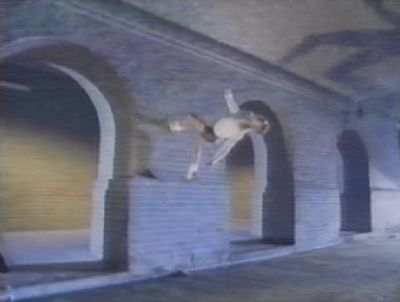 The bartender runs in place, throws his rag in the air, and somersaults over the bar. He is running neck and neck with Tom Cruise’s Cocktail performance for the “Craziest Bartender of 1988” medal. The blondes keep on looking over their shoulders at the camera. Another man enters the video; he’s even blonder than the girls. Now and then, the editor cuts to a brief clip of Rick’s shadow. The bartender has come outside so he can jump against the chain link fence, bouncing off it in an acrobatic fashion. Super-blonde guy turns out to be a pretty good dancer, swiveling his body and spinning on his knees. The bartender runs up the stone wall and flips his body into a somersault, which is a real Matrix move without the benefit of a special-effects budget. Man, I hope whoever played the bartender parlayed this video into a West End show or an Olympics medal or something.
The bartender runs in place, throws his rag in the air, and somersaults over the bar. He is running neck and neck with Tom Cruise’s Cocktail performance for the “Craziest Bartender of 1988” medal. The blondes keep on looking over their shoulders at the camera. Another man enters the video; he’s even blonder than the girls. Now and then, the editor cuts to a brief clip of Rick’s shadow. The bartender has come outside so he can jump against the chain link fence, bouncing off it in an acrobatic fashion. Super-blonde guy turns out to be a pretty good dancer, swiveling his body and spinning on his knees. The bartender runs up the stone wall and flips his body into a somersault, which is a real Matrix move without the benefit of a special-effects budget. Man, I hope whoever played the bartender parlayed this video into a West End show or an Olympics medal or something.
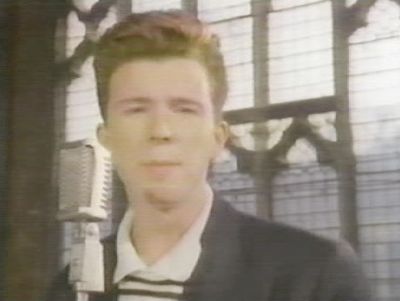 We cut between Rick’s various looks as he keeps repeating the chorus. (“Never gonna” is heard fully forty times in this song). Rick has a big grin on his face, and seems totally unconnected to the song emotionally. This is the track’s big flaw: when the chorus was misheard as “Now I’m gonna give you up,” as it frequently was, it seemed just as plausible a lyric. Rick’s vocal performance didn’t give you any emotional cues as to whether he wanted to pick out silverware together or to ditch you by the side of the road with some loose change for the bus.
We cut between Rick’s various looks as he keeps repeating the chorus. (“Never gonna” is heard fully forty times in this song). Rick has a big grin on his face, and seems totally unconnected to the song emotionally. This is the track’s big flaw: when the chorus was misheard as “Now I’m gonna give you up,” as it frequently was, it seemed just as plausible a lyric. Rick’s vocal performance didn’t give you any emotional cues as to whether he wanted to pick out silverware together or to ditch you by the side of the road with some loose change for the bus.
“Never Gonna Give You Up,” as Adam Curry mentioned, hit number one–for two weeks in the US and five weeks in the UK. (It was followed later in 1988 by the soundalike number-one single “Together Forever,” which we covered early in this countdown.) You can watch it here.
posted 19 August 2013 in 1988 and tagged Rick Astley, Stock-Aitken-Waterman. 9 comments

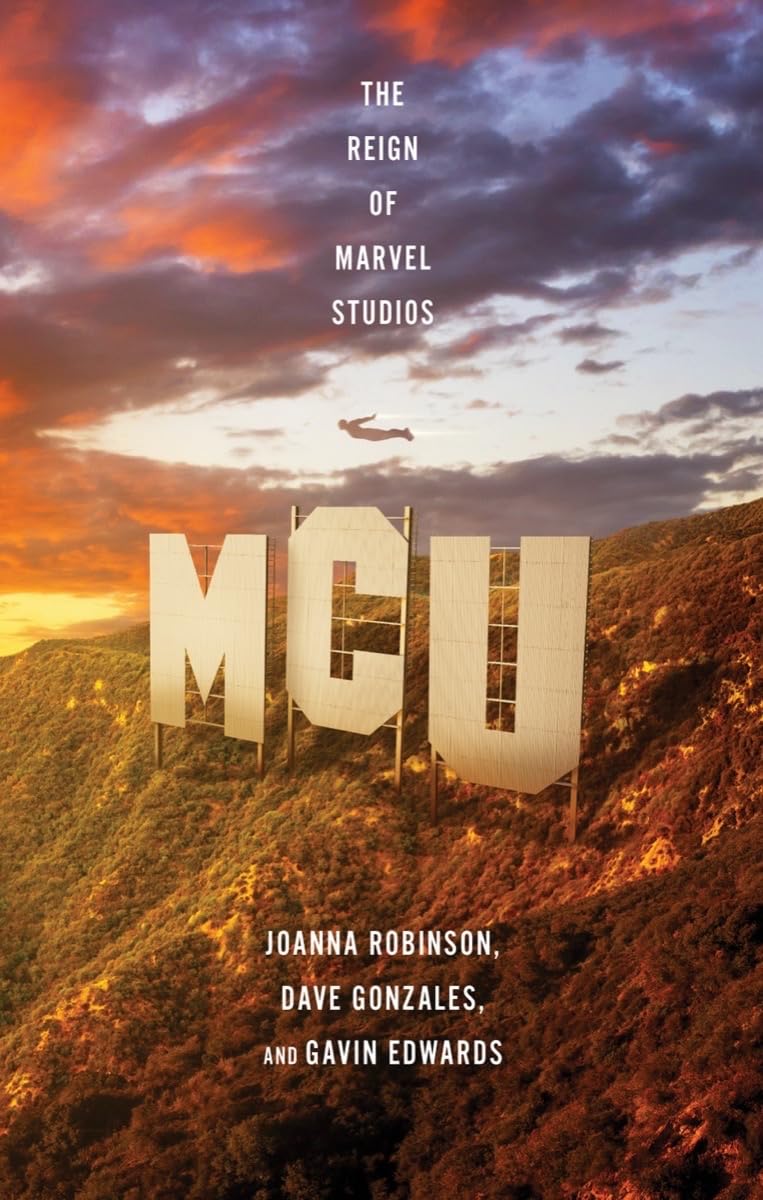
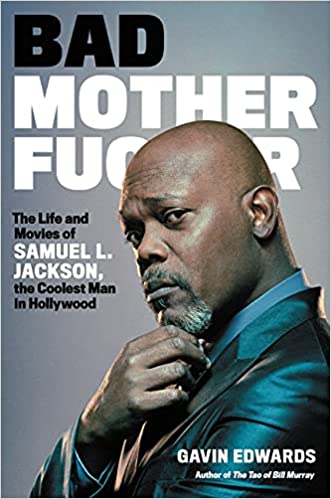
August 19th, 2013 at 10:08 am
It also helps to have somebody in this video who can really dance, since it is basically a disco tune.
I’m glad you mentioned this, because this is what, to my 16-year-old ears, was so remarkable about “Never Gonna Give You Up” when it emerged at the end of 1987: It made Top 40 safe for disco—stuff that actually sounded like disco—after seven years in the wilderness.
“But what about Madonna?” you might reasonably scoff. Yes, but the thing that made Madonna a genius from 1983 to 1987 was that she essentially redeemed disco music from its post-1980 shunning by hiding it—dressing it up (pun intended) in rock, new wave, electro and hip-hop guises. All that time, her songs mostly avoided anything that smacked of a ride-cymbal beat or disco strings. She blew an air-kiss to the disco sound in the summer of 1986 on “Papa Don’t Preach,” kicking the song off with roughly 20 seconds of pure disco strings; but then she turned right to vintage-’86 gated drums when the beat kicked in, and other than some string flourishes toward the end of the song, she stayed away from outright disco for the bulk of the track. All the Madonna-bes who followed in her wake were imitating the sound of “Borderline” (or the sound disco refugee Nile Rodgers perfected on his Madonna productions), not the sound of Chic.
Stock-Aitken-Waterman were shameless lovers of the uncut stuff. But even they shied away from pushing the pure disco sound in America initially—their first U.S. No. 1 hit, Banarama’s 1986 cover of “Venus,” was electro-dance, more a hybrid of the girl group’s sound on their 1984 electro classic “Cruel Summer” with SAW’s echt-disco approach. SAW came closer to reviving disco on those early Kylie and Jason Donovan tracks, but those weren’t hits in America.
I recall my first time seeing this Astley video on MTV around Christmas of ’87; because I was already a Billboard reader, I knew it had been a hit in England, and so it made sense that RCA would push it here. But my jaw dropped when I heard those synth-strings. As a kid who grew up in Bensonhurst, the cradle of Travolta-era disco, I was stunned that a major record label would try, in 1987, to flog something so shamelessly indebted to the ’70s.
My whole existence at that time consisted of trying to pretend I didn’t still love the Bee Gees and Donna Summer. And then Astley had a hit, and it wasn’t weird to hear music arranged like Donna Summer on the radio anymore. By 1989, SAW were actually working with Summer herself and making her sound like 1978 all over again, without guile, and getting her back in the U.S. Top 10 (“This Time I Know It’s for Real”).
I’m telling you—as slight as Rick Astley was, and all Rickroll jokes aside, this song was an important sonic gearshift when it topped the charts. It sounds conventional now, but nothing on U.S. pop radio in early ’88 sounded like this.
August 19th, 2013 at 10:33 am
I think you are right, Chris, although I didn’t have that reaction to the song at the time. That may be because I had already turned a corner on embracing my ten-years-prior love of disco, and was finding used Barry White albums for a dollar and playing them to death.
Also: the Miami sound was big that year, and that was basically disco, wasn’t it? “Domino Dancing” postdated “NGGYU” by about six months, but there were big Exposé hits that came before it.
August 19th, 2013 at 10:51 am
To me, Exposé (whom I love; “Let Me Be the One” is the greatest ’80s gothic dance-pop song, even if it’s a category of one) and Lewis Martineé were doing what Madonna was doing, just pointing it in a different, Miami-bound direction. “Come Go with Me,” “Point of No Return”: they’re good dance songs, but they are dressing themselves in high-NRG post-electro beats; said beats are just different than Madge’s.
Even the great “Domino Dancing” is something of a hybrid, sonically. But I agree with you that the Pet Shop Boys were moving more decisively in the direction of pure disco on Introspective—ironic for a duo who had already titled an EP Disco in 1986.
August 20th, 2013 at 7:20 pm
Thanks for the link! That was a fun project, and I’m grateful that someone remembers it.
August 22nd, 2013 at 3:12 pm
Here’s a link to the Pop-Up Video on this one: http://www.youtube.com/watch?v=jmKrJ4SeyiQ. Lot of fun facts, including this being one of the first things done by Simon West of Con Air infamy. Definitely got some slo-mo practice in here.
As for the song’s disco leanings, I’d call it neo-disco. It has the Yamaha keyboard signature sound so prevalent in the second half of the decade. (Another post-disco song that was big in the day, and one of the best, would be “Chains of Love” by Erasure.)
This had to be one of the last times MTV played Rick. None of his albums had any videos garner any airplay to my knowledge.
He did really well on the MTV top 20 though with this video, going all the way to #2. Oddly enough though, in the entirety of his 9 week run, he ranked below the last video on this chart, “Just Like Paradise” by David Lee Roth. He’d also been rickroll’d by a band with a couple of other Ricks: Allen and Savage from Def Leppard, who went to the top instead, but we’ll see those guys later. (Sorry, couldn’t resist that lame pun.)
November 25th, 2016 at 5:43 am
Disco? It may have had influence from Disco, but it could hardly be considered disco. Clearly 80’s pop dance.
February 8th, 2017 at 3:28 pm
One of the better videos of the late 80’s. Who were the two Blonde backup dancers? I think they made the video fit nicely together.
Thanks
October 22nd, 2017 at 11:06 am
Who is the blonde back-up-dancer-girl, which dance in the video to “Never gonna give you up” and in “She wants to dance with me”..? In the second video she stands beside Rick, singing on the microphone ( in a grey suit..) and dancing.. she is so beautiful…
Please answer.. Very greeting from Germany.. Music of my
Generation..!!
October 19th, 2020 at 8:30 pm
Wow the song Never gonna give you up is stl popping here in the USA 20/20. U gotta love Rick.